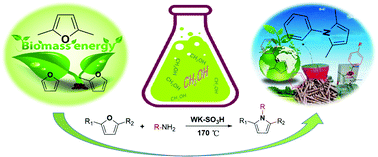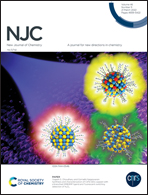Magnetic solid sulfonic acid-enabled direct catalytic production of biomass-derived N-substituted pyrroles†
Abstract
Five-membered nitrogen heterocyclic pyrroles have extremely high physiological activity and are widely used in medicine, agriculture, materials chemistry, industry, and supramolecular chemistry. Developing a mild and eco-friendly way to synthesize functionalized pyrroles from biologically derived materials is desirable. In this study, biomass-derived 2,5-dimethylfuran can react with a series of aromatic amines to synthesize 2,5-dimethyl-N-arylpyrroles through acid-enabled ring-opening and Paal–Knorr condensation in one pot. Among the tested acid catalytic materials, a new magnetic biocarbon-based sulfonic acid solid catalyst (WK-SO3H) showed excellent catalytic performance in the synthesis of N-substituted pyrroles (up to ca. 90% yield) and was easy to separate and recover by an external magnetic field. The ring-opening of furan proved to be the rate-determining step of the above one-pot multi-step conversion process, and 2,5-hexanedione is a key intermediate for the cascade reaction, while the addition of water could significantly enhance the above-mentioned ring-opening reaction. Furthermore, multiple characterization methods (e.g., FT-IR, TGA, XRD, NH3-TPD, and XPS) confirmed that WK-SO3H has good stability in the aqueous reaction system.



 Please wait while we load your content...
Please wait while we load your content...